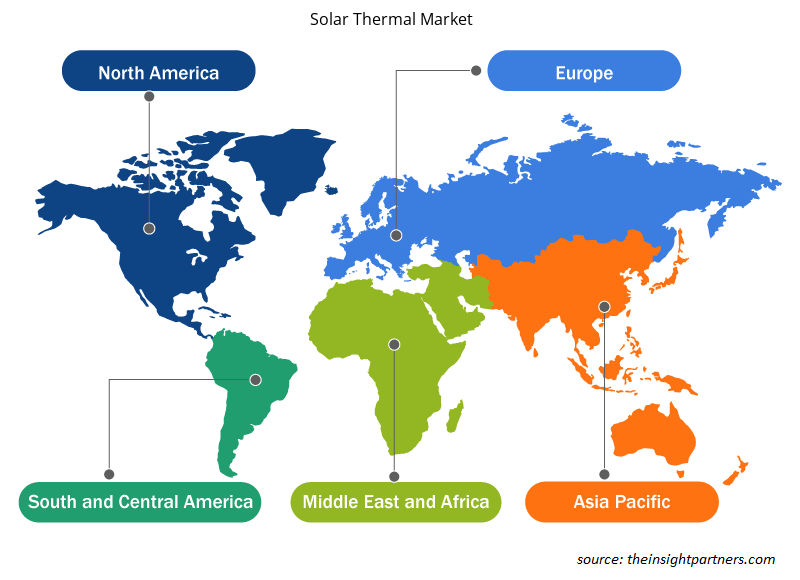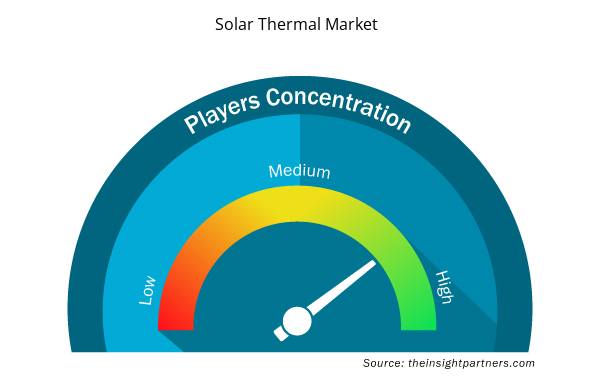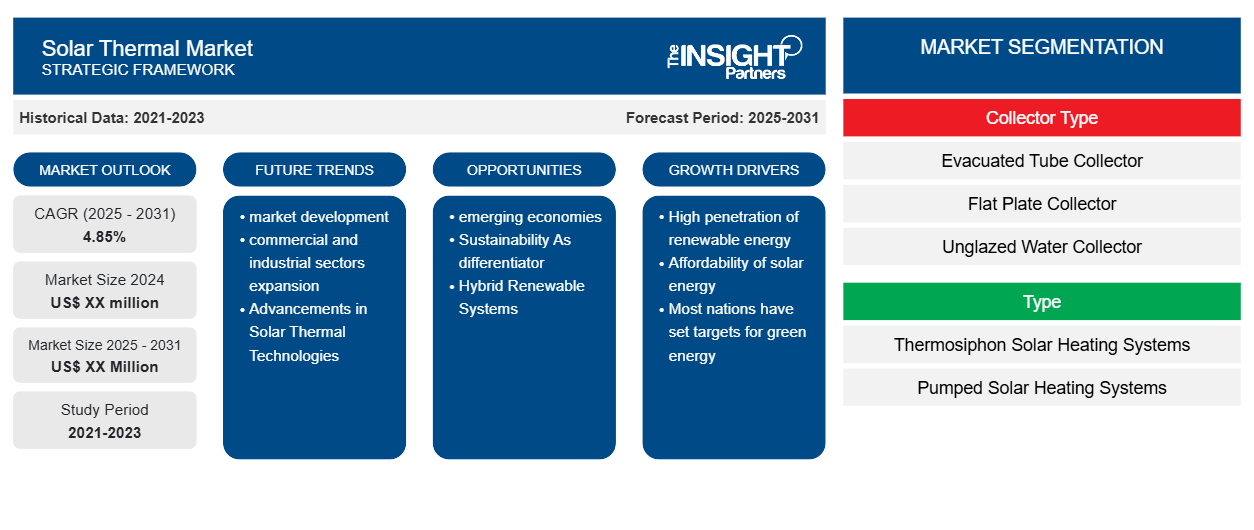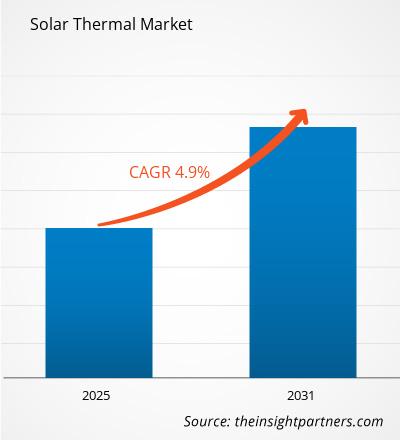Es wird erwartet, dass der Markt für Solarthermie von 2024 bis 2031 eine durchschnittliche jährliche Wachstumsrate (CAGR) von 4,85 % verzeichnet und dass die Marktgröße von XX Millionen US-Dollar im Jahr 2024 auf XX Millionen US-Dollar im Jahr 2031 anwächst.
Der Bericht über den Solarthermiemarkt bietet eine detaillierte Analyse basierend auf Technologie, Anwendungen und geografischen Regionen. Dieser Bericht umfasst eine detaillierte regionale Segmentierung mit Schwerpunkt auf allen wichtigen Märkten und Ländern und bietet somit einen globalen Ausblick. Die Marktanalysen werden in US-Dollar (US$) bereitgestellt. Dieser Bericht soll den Beteiligten helfen, die Dynamik des Marktes sowie Wachstumstrends und die Wettbewerbslandschaft des Marktes in verschiedenen Segmenten zu verstehen. Er soll es ihnen ermöglichen, Chancen zu erkennen und strategische Entscheidungen auf dem wachsenden Solarthermiemarkt zu treffen.
Zweck des Berichts
Der Bericht Solar Thermal Market von The Insight Partners soll die aktuelle Landschaft und das zukünftige Wachstum sowie die wichtigsten treibenden Faktoren, Herausforderungen und Chancen beschreiben. Dies wird verschiedenen Geschäftspartnern Einblicke geben, wie zum Beispiel:
- Technologieanbieter/-hersteller: Um die sich entwickelnde Marktdynamik zu verstehen und die potenziellen Wachstumschancen zu kennen, damit sie fundierte strategische Entscheidungen treffen können.
- Investoren: Durchführung einer umfassenden Trendanalyse hinsichtlich der Marktwachstumsrate, der finanziellen Marktprognosen und der Chancen entlang der Wertschöpfungskette.
- Regulierungsbehörden: Zur Regulierung von Richtlinien und Überwachungsaktivitäten auf dem Markt mit dem Ziel, Missbrauch zu minimieren, das Vertrauen der Anleger zu bewahren und die Integrität und Stabilität des Marktes aufrechtzuerhalten.
Solarthermie-Marktsegmentierung
Kollektortyp
- Vakuumröhrenkollektor
- Flachkollektor
- Unglasierter Wassersammler
- Luftsammler
Typ
- Thermosiphon-Solarheizsysteme
- Gepumpte Solar-Heizsysteme
Anwendung
- Brauchwarmwassersysteme
- Große Warmwassersysteme
- Solar-Kombi-Anlage
Geographie
- Nordamerika
- Europa
- Asien-Pazifik
- Süd- und Mittelamerika
- Naher Osten und Afrika
Passen Sie diesen Bericht Ihren Anforderungen an
Sie erhalten kostenlos individuelle Anpassungen an jedem Bericht, einschließlich Teilen dieses Berichts oder einer Analyse auf Länderebene, eines Excel-Datenpakets sowie tolle Angebote und Rabatte für Start-ups und Universitäten.
- Holen Sie sich die wichtigsten Markttrends aus diesem Bericht.Dieses KOSTENLOSE Beispiel umfasst eine Datenanalyse von Markttrends bis hin zu Schätzungen und Prognosen.
Wachstumstreiber auf dem Solarthermiemarkt
- Hohe Verbreitung erneuerbarer Energien: Der Solarthermiemarkt ist in hohem Maße durch eine hohe Verbreitung erneuerbarer Energielösungen gekennzeichnet. Solarthermiesysteme machen etwa 15 % des gesamten Solarenergiemarktes aus. Verschiedene staatliche Anreize in Form von Steuergutschriften und Rabatten haben dazu geführt, dass die Installation dieser Geräte im Wohnbereich in den letzten fünf Jahren um etwa 20 % zugenommen hat.
- Erschwinglichkeit von Solarenergie: Solarthermische Technologien sind für Verbraucher erschwinglich geworden, da ihre Preise seit 2010 um etwa 40 % gefallen sind.
- Die steigende Nachfrage nach Heizanwendungen auf Basis erneuerbarer Energiequellen im Wohn- und Gewerbebereich sowie die durch Eigenstromerzeugung reduzierten Energiekosten werden den Marktanteil der Solarthermie in den kommenden Jahren voraussichtlich steigern. Ähnlich wie bei der Fernwärme dürfte die vorherrschende Konkurrenz durch Erdgas das Wachstum des Solarthermiemarktes in Kürze zum Erliegen bringen.
- Die meisten Länder haben sich Ziele für grüne Energie gesetzt: Daher ist der Trend zur Nutzung von Solarthermie in allen Regionen in letzter Zeit gestiegen. Auf dem Markt für Solarthermieanlagen dominiert der asiatisch-pazifische Raum, wo China den größten Anteil hat. China hat die höchste Anzahl an Anlagen aller Zeiten installiert und verfügt auch über eine starke Strategie für die Installation, die innerhalb des Prognosezeitraums umgesetzt wird. Die wichtigsten Treiber für das regionale Wachstum werden Pläne zur Elektrifizierung ländlicher Gebiete, die Umsetzung von Zielen für grüne Energie durch wichtige Länder, Bevölkerungswachstum und die steigende Nachfrage nach sauberer Energie sein.
Zukünftige Trends auf dem Solarthermiemarkt
- Marktentwicklung: Es wird auch davon ausgegangen, dass das Segment für Privathaushalte im Prognosezeitraum für den Solarthermiemarkt am schnellsten wachsen wird, da die Installation von Solarfernwärmeanlagen in allen Regionen zunimmt. Dies würde im Falle der Einführung von Solarheizsystemen für die industrielle Prozesswärme zahlreiche Möglichkeiten für die Marktentwicklung bedeuten. Viele Unternehmen haben die wirtschaftliche Rentabilität von Solarheizsystemen für den gewerblichen und industriellen Sektor bereits getestet. Das beste Beispiel ist das vom Bundesverband Solarwirtschaft e. V. initiierte Solar Payback-Projekt. Es hat in letzter Zeit vier Ländern geholfen, den Weg für die Nutzung von Solarwärme für industrielle Prozesse zu ebnen: Südafrika, Brasilien, Mexiko und Indien. Da die Installation von Solarfernwärmeanlagen weltweit zunimmt, wird erwartet, dass das Segment für Privathaushalte im Prognosezeitraum den Markt dominieren wird.
- Expansion im gewerblichen und industriellen Sektor: Mit der Einführung von Solarwärmesystemen für industrielle Prozesse ergeben sich zahlreiche Aussichten auf eine Marktexpansion. Die wirtschaftliche Rentabilität von Solarwärmesystemen im gewerblichen und industriellen Sektor wurde von zahlreichen Unternehmen erfolgreich getestet. Das Solar Payback-Projekt, das vom deutschen Bundesverband Solarwirtschaft e. V. ins Leben gerufen wurde, ist das beste Beispiel. Es förderte kürzlich die Nutzung von Solarwärme für industrielle Prozesse (SHIP) in vier Ländern: Südafrika, Brasilien, Mexiko und Indien.
- Fortschritte bei thermischen Solartechnologien: Innovationen bei konzentrierenden Solarstromsystemen (CSP), verbesserte thermische Speicherlösungen und moderne Materialien für Solarkollektoren steigern die Effizienz und Kosteneffizienz.
Marktchancen für Solarthermie
- Schwellenländer: Schwellenländer bieten eine große Chance, da Regionen wie Afrika aufgrund des steigenden Energiebedarfs ein jährliches Wachstum von 25 % bei der Installation von Solarthermieanlagen verzeichnen. Dies kann durch gemeinsame Anstrengungen des Unternehmens mit lokalen Regierungen zur Verbreitung der Nutzung von Solarthermieanlagen gefördert werden.
- Nachhaltigkeit als Differenzierungsmerkmal: Angesichts des zunehmenden Interesses der Verbraucher an Nachhaltigkeit werden sich Unternehmen in diesem wettbewerbsintensiven Markt durch Produkte mit Schwerpunkt auf Umweltfreundlichkeit und Energieeffizienz von der Konkurrenz abheben.
- Hybride erneuerbare Systeme: Die Integration von Solarthermie mit anderen erneuerbaren Quellen wie Biomasse oder Wind bietet Möglichkeiten zur Entwicklung von Hybridsystemen, die eine kontinuierliche Energieversorgung gewährleisten können.
Regionale Einblicke in den Solarthermiemarkt
Die regionalen Trends und Faktoren, die den Solarthermiemarkt im Prognosezeitraum beeinflussen, wurden von den Analysten von Insight Partners ausführlich erläutert. In diesem Abschnitt werden auch die Marktsegmente und die Geografie des Solarthermiemarkts in Nordamerika, Europa, im asiatisch-pazifischen Raum, im Nahen Osten und Afrika sowie in Süd- und Mittelamerika erörtert.

- Erhalten Sie regionale Daten zum Solarthermiemarkt
Umfang des Solarthermie-Marktberichts
| Berichtsattribut | Details |
|---|---|
| Marktgröße im Jahr 2024 | XX Millionen US-Dollar |
| Marktgröße bis 2031 | XX Millionen US-Dollar |
| Globale CAGR (2025 - 2031) | 4,85 % |
| Historische Daten | 2021-2023 |
| Prognosezeitraum | 2025–2031 |
| Abgedeckte Segmente | Nach Sammlertyp
|
| Abgedeckte Regionen und Länder | Nordamerika
|
| Marktführer und wichtige Unternehmensprofile |
|
Dichte der Akteure auf dem Solarthermiemarkt: Deren Einfluss auf die Geschäftsdynamik
Der Markt für Solarthermie wächst rasant. Dies wird durch die steigende Nachfrage der Endnutzer aufgrund von Faktoren wie sich entwickelnden Verbraucherpräferenzen, technologischen Fortschritten und einem größeren Bewusstsein für die Vorteile des Produkts vorangetrieben. Mit der steigenden Nachfrage erweitern Unternehmen ihr Angebot, entwickeln Innovationen, um die Bedürfnisse der Verbraucher zu erfüllen, und nutzen neue Trends, was das Marktwachstum weiter ankurbelt.
Die Marktteilnehmerdichte bezieht sich auf die Verteilung der Firmen oder Unternehmen, die in einem bestimmten Markt oder einer bestimmten Branche tätig sind. Sie gibt an, wie viele Wettbewerber (Marktteilnehmer) in einem bestimmten Marktraum im Verhältnis zu seiner Größe oder seinem gesamten Marktwert präsent sind.
Die wichtigsten auf dem Solarthermiemarkt tätigen Unternehmen sind:
- Abengoa Solar
- BrightSource Energie
- HTP Comfort Solutions LLC
- Lointek
- Robert Bosch
Haftungsausschluss : Die oben aufgeführten Unternehmen sind nicht in einer bestimmten Reihenfolge aufgeführt.

- Überblick über die wichtigsten Akteure auf dem Solarthermiemarkt
Wichtige Verkaufsargumente
- Umfassende Abdeckung: Der Bericht deckt die Analyse von Produkten, Dienstleistungen, Typen und Endbenutzern des Solarthermie-Marktes umfassend ab und bietet einen ganzheitlichen Überblick.
- Expertenanalyse: Der Bericht basiert auf dem umfassenden Verständnis von Branchenexperten und Analysten.
- Aktuelle Informationen: Der Bericht stellt durch die Abdeckung aktueller Informationen und Datentrends Geschäftsrelevanz sicher.
- Anpassungsoptionen: Dieser Bericht kann angepasst werden, um spezifische Kundenanforderungen zu erfüllen und die Geschäftsstrategien optimal anzupassen.
Der Forschungsbericht zum Solarthermiemarkt kann daher dabei helfen, die Branchensituation und Wachstumsaussichten zu entschlüsseln und zu verstehen. Obwohl es einige berechtigte Bedenken geben kann, überwiegen die allgemeinen Vorteile dieses Berichts tendenziell die Nachteile.
- Historische Analyse (2 Jahre), Basisjahr, Prognose (7 Jahre) mit CAGR
- PEST- und SWOT-Analyse
- Marktgröße Wert/Volumen – Global, Regional, Land
- Branche und Wettbewerbsumfeld
- Excel-Datensatz



Report Coverage
Revenue forecast, Company Analysis, Industry landscape, Growth factors, and Trends

Segment Covered
This text is related
to segments covered.

Regional Scope
North America, Europe, Asia Pacific, Middle East & Africa, South & Central America

Country Scope
This text is related
to country scope.
Häufig gestellte Fragen
The report can be delivered in PDF/PPT format; we can also share excel dataset based on the request.
Some of the customization options available based on request are additional 3-5 company profiles and country-specific analysis of 3-5 countries of your choice. Customizations are to be requested/discussed before making final order confirmation, as our team would review the same and check the feasibility.
Key Players in this market are - Abengoa Solar, BrightSource Energy, HTP Comfort Solutions LLC, Lointek, Robert Bosch, SCHOTT, Sener, Siemens, SolarReserve, Sunrain
The market is expected to register a CAGR of 4.5% during 2023-2031
The solar thermal market is a growing segment, thanks to the rising adaptation of renewable energy sources, which governments incentivize in order to reduce the capital burden, with costs of technology falling. Surging energy prices and urbanization forced consumers toward efficient heating solutions, while continuous improvements in thermal storage enhanced the reliability and attractiveness of the systems.
Future trends include hybrid systems combining solar thermal with heat pumps for improved efficiency. Smart technology integration will optimize energy management, while industrial applications are expanding. Sustainable building practices will drive the incorporation of solar thermal systems in new construction projects.
Trends and growth analysis reports related to Energy and Power : READ MORE..
1.Abengoa Solar
2.BrightSource Energy
3.HTP Comfort Solutions LLC
4.Lointek
5.Robert Bosch
6.SCHOTT
7.Sener
8.Siemens
9.SolarReserve
10.Sunrain
The Insight Partners performs research in 4 major stages: Data Collection & Secondary Research, Primary Research, Data Analysis and Data Triangulation & Final Review.
- Data Collection and Secondary Research:
As a market research and consulting firm operating from a decade, we have published and advised several client across the globe. First step for any study will start with an assessment of currently available data and insights from existing reports. Further, historical and current market information is collected from Investor Presentations, Annual Reports, SEC Filings, etc., and other information related to company’s performance and market positioning are gathered from Paid Databases (Factiva, Hoovers, and Reuters) and various other publications available in public domain.
Several associations trade associates, technical forums, institutes, societies and organization are accessed to gain technical as well as market related insights through their publications such as research papers, blogs and press releases related to the studies are referred to get cues about the market. Further, white papers, journals, magazines, and other news articles published in last 3 years are scrutinized and analyzed to understand the current market trends.
- Primary Research:
The primarily interview analysis comprise of data obtained from industry participants interview and answers to survey questions gathered by in-house primary team.
For primary research, interviews are conducted with industry experts/CEOs/Marketing Managers/VPs/Subject Matter Experts from both demand and supply side to get a 360-degree view of the market. The primary team conducts several interviews based on the complexity of the markets to understand the various market trends and dynamics which makes research more credible and precise.
A typical research interview fulfils the following functions:
- Provides first-hand information on the market size, market trends, growth trends, competitive landscape, and outlook
- Validates and strengthens in-house secondary research findings
- Develops the analysis team’s expertise and market understanding
Primary research involves email interactions and telephone interviews for each market, category, segment, and sub-segment across geographies. The participants who typically take part in such a process include, but are not limited to:
- Industry participants: VPs, business development managers, market intelligence managers and national sales managers
- Outside experts: Valuation experts, research analysts and key opinion leaders specializing in the electronics and semiconductor industry.
Below is the breakup of our primary respondents by company, designation, and region:

Once we receive the confirmation from primary research sources or primary respondents, we finalize the base year market estimation and forecast the data as per the macroeconomic and microeconomic factors assessed during data collection.
- Data Analysis:
Once data is validated through both secondary as well as primary respondents, we finalize the market estimations by hypothesis formulation and factor analysis at regional and country level.
- Macro-Economic Factor Analysis:
We analyse macroeconomic indicators such the gross domestic product (GDP), increase in the demand for goods and services across industries, technological advancement, regional economic growth, governmental policies, the influence of COVID-19, PEST analysis, and other aspects. This analysis aids in setting benchmarks for various nations/regions and approximating market splits. Additionally, the general trend of the aforementioned components aid in determining the market's development possibilities.
- Country Level Data:
Various factors that are especially aligned to the country are taken into account to determine the market size for a certain area and country, including the presence of vendors, such as headquarters and offices, the country's GDP, demand patterns, and industry growth. To comprehend the market dynamics for the nation, a number of growth variables, inhibitors, application areas, and current market trends are researched. The aforementioned elements aid in determining the country's overall market's growth potential.
- Company Profile:
The “Table of Contents” is formulated by listing and analyzing more than 25 - 30 companies operating in the market ecosystem across geographies. However, we profile only 10 companies as a standard practice in our syndicate reports. These 10 companies comprise leading, emerging, and regional players. Nonetheless, our analysis is not restricted to the 10 listed companies, we also analyze other companies present in the market to develop a holistic view and understand the prevailing trends. The “Company Profiles” section in the report covers key facts, business description, products & services, financial information, SWOT analysis, and key developments. The financial information presented is extracted from the annual reports and official documents of the publicly listed companies. Upon collecting the information for the sections of respective companies, we verify them via various primary sources and then compile the data in respective company profiles. The company level information helps us in deriving the base number as well as in forecasting the market size.
- Developing Base Number:
Aggregation of sales statistics (2020-2022) and macro-economic factor, and other secondary and primary research insights are utilized to arrive at base number and related market shares for 2022. The data gaps are identified in this step and relevant market data is analyzed, collected from paid primary interviews or databases. On finalizing the base year market size, forecasts are developed on the basis of macro-economic, industry and market growth factors and company level analysis.
- Data Triangulation and Final Review:
The market findings and base year market size calculations are validated from supply as well as demand side. Demand side validations are based on macro-economic factor analysis and benchmarks for respective regions and countries. In case of supply side validations, revenues of major companies are estimated (in case not available) based on industry benchmark, approximate number of employees, product portfolio, and primary interviews revenues are gathered. Further revenue from target product/service segment is assessed to avoid overshooting of market statistics. In case of heavy deviations between supply and demand side values, all thes steps are repeated to achieve synchronization.
We follow an iterative model, wherein we share our research findings with Subject Matter Experts (SME’s) and Key Opinion Leaders (KOLs) until consensus view of the market is not formulated – this model negates any drastic deviation in the opinions of experts. Only validated and universally acceptable research findings are quoted in our reports.
We have important check points that we use to validate our research findings – which we call – data triangulation, where we validate the information, we generate from secondary sources with primary interviews and then we re-validate with our internal data bases and Subject matter experts. This comprehensive model enables us to deliver high quality, reliable data in shortest possible time.


 Holen Sie sich ein kostenloses Muster für diesen Bericht
Holen Sie sich ein kostenloses Muster für diesen Bericht